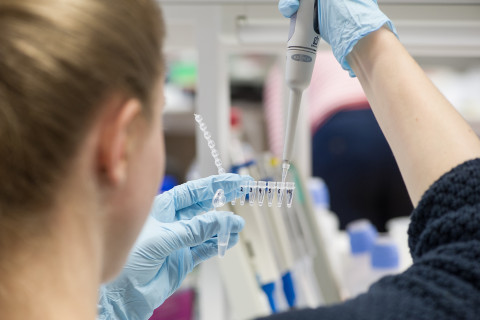The international EADB consortium has discovered dozens of new gene variants associated with the risk of Alzheimer’s disease. A significant proportion of these newly discovered variants are essentially linked to the function of brain microglial cells and the regulation of beta-amyloid production. The results provide further support for the role of brain protein accumulation and inflammation in Alzheimer’s disease.
Alzheimer’s disease is the most common dementia-causing multifactorial memory disorder, with genetic factors playing a key role. Knowing the genetic background of Alzheimer’s disease is crucial for disease prevention, as well as for understanding the cellular level mechanisms of the disease. In recent years, genome-wide association studies to identify risk genes have led in considerable advances in understanding the genetic pathogenesis of Alzheimer’s disease. Since 2015, the Molecular Genetics of Alzheimer’s Disease group at the University of Eastern Finland has, together with eight other European research groups, been leading the EADB consortium (European DNA Bank for Deciphering the Missing Heritability of Alzheimer’s Disease), which aims at identifying new risk variants from extensive European datasets, including both Alzheimer’s disease patients and controls. The EADB consortium was originally launched under funding from the EU Joint Programme – Neurodegenerative Disease Research, JPND, in which the Academy of Finland was one of the funders.
Newly discovered risk genes highlight the role of brain microglial cells in Alzheimer’s disease
Published in Nature Genetics, the study discovered 75 gene loci, 42 of which previously unknown, that significantly modify the risk of Alzheimer’s disease. The study is one of the largest genome-wide Alzheimer’s risk gene studies to date, involving hundreds of thousands of Alzheimer’s patients and controls. The most interesting risk gene loci identified in the EADB data were also further examined in other available European and US patient-control cohorts, in biobanks, and in the Alzheimer’s disease patient cohort of the Finnish FinnGen research project. Further studies in the FinnGen data confirmed the significance of several targets as genetic risk factors for Alzheimer’s disease. Based on the EADB data, the researchers also constructed a genetic risk score, which effectively predicts the future risk of people with mild cognitive impairment to develop Alzheimer’s disease.
Changes related to the risk of Alzheimer’s disease were observed especially in genes associated with the function and activation of the immune cells, particularly microglia, as well as in genes associated with the regulation of beta-amyloid production. There were also significant changes in genes involved in the endocytosis of proteins in microglial cells, and thus, also in metabolic changes in the amyloid precursor protein (APP), a precursor of beta-amyloid. The study also identified changes in regulatory genes associated with the function of the tau protein as well as in genes that are active in inflammation on the tumour necrosis factor alpha (TNF-alpha) mediated signalling pathway.
“These observations support the already well-established concept of beta-amyloid and tau protein aggregation playing a key role in the development of Alzheimer’s disease. However, they also reinforce the recent perspective that microglial cells and brain inflammation may play an increasingly important role in the disease,” says Professor Mikko Hiltunen, Director of the research group for Molecular Genetics of Alzheimer’s Disease at the University of Eastern Finland.
The results of the study will contribute to the identification of new cellular level disease mechanisms, the discovery of new targets for drug therapy, and the development of individualised diagnostics for Alzheimer’s disease.
For further information, please contact:
Professor Mikko Hiltunen, tel. +358 40 355 2014, mikko.hiltunen (at) uef.fi
University of Eastern Finland, Institute of Biomedicine, Kuopio
Research article:
Bellenguez, C. et al. New insights into the genetic etiology of Alzheimer’s disease and related dementias. Nature Genetics, published on 4 April 2022. https://www.nature.com/articles/s41588-022-01024-z
This research group is a member of the multidisciplinary Neuroscience Research Community (NEURO RC) at the University of Eastern Finland. NEURO RC aims to understand the disease-specific and common molecular mechanisms underlying neurodegenerative diseases and epilepsy and to identify novel biomarkers and therapeutic approaches for their prevention and cure. Comprising 17 research groups, NEURO RC integrates biological neurosciences with data sciences, neuro-innovations, and neuro-ethics. Learn more and connect with NEURO RC:
Website: https://www.uef.fi/en/research-community/neuroscience-neuro
Twitter: https://twitter.com/UEFneuroscience



